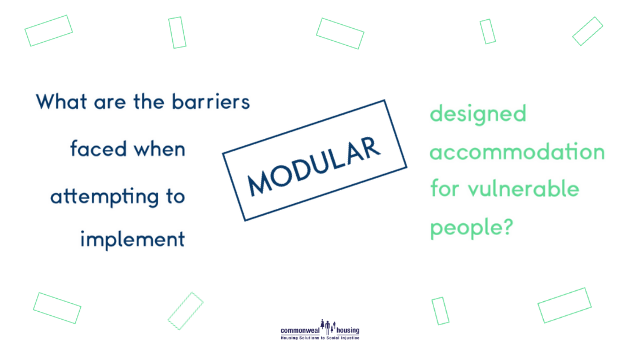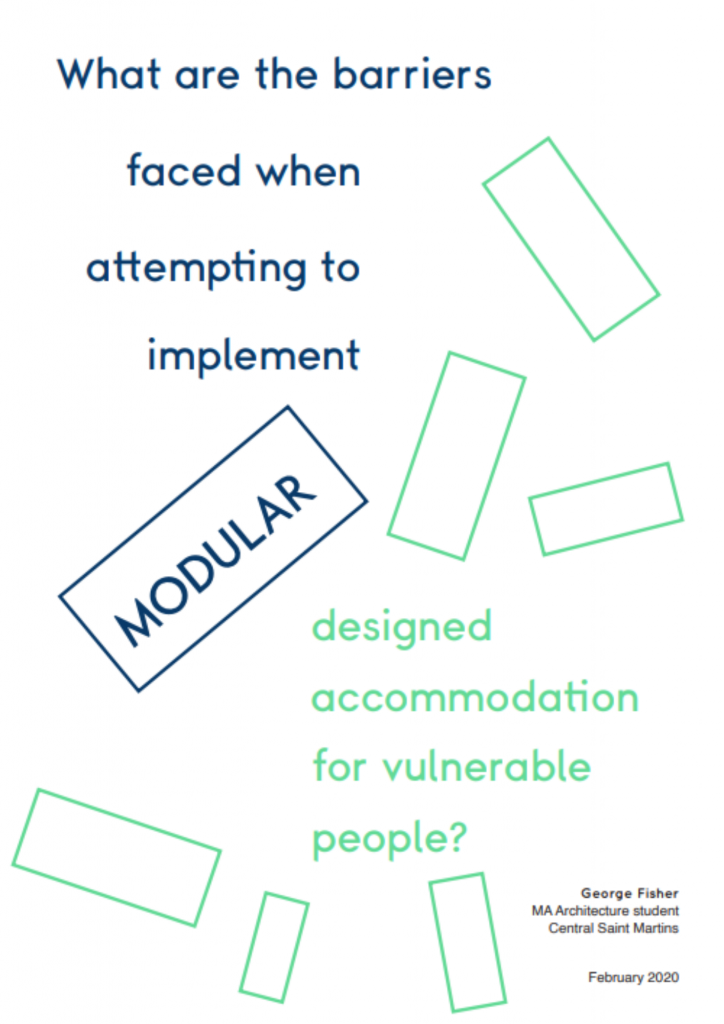
We must collaborate to promote innovative modular housing for vulnerable people

George Fisher is the author of What are the barriers faced when attempting to implement modular designed accommodation for vulnerable people?. He is a collaborator with Commonweal Housing and Reed Watts Architects on our development of the Pods project, and is currently completing an MA in Architecture at Central Saint Martins.
It wasn’t until the post-war era that modular design was first used on a mass scale. However, as the passing of time revealed the general poor quality of these prefabricated homes through incidents such as the Ronan Point Disaster of 1968, the use of modular design in housing became much less popular.
In spite of this, as technology and construction methods have advanced and improved, it has been demonstrated that modular designed accommodation can be built with quality and speed.
Mark Farmer’s ‘Review of the UK construction Labour Model’, commissioned by the government, concluded that the construction sector must ‘modernise or die’ and suggested that the government should promote the use of pre-manufactured solutions in the housing sector.
Over the last decade we have seen a surge of innovation surrounding the use of modular construction to house vulnerable communities on ‘meanwhile-use’ sites.
Examples include the conversion of existing shipping container units into dwellings such as Help Bristol’s Homeless’s containers, or through the manufacturing of completely new modular units such as those seen in the Salvation Army’s Project Malachi in Ilford.
A non-profit organisation called PLACE has been set up to tackle homelessness in London and is aiming to have a resource of 200 modular accommodation units by 2021 to distribute to councils across London.
It is clear that modular construction is beginning to become synonymous with housing for vulnerable people, and the innovation taking place in this space is exciting.
At a smaller scale, I have been working in collaboration with Reed Watts Architects and Commonweal Housing, to design and install 18 modular plywood sleeping pods for a Salvation Army night-shelter in Ilford, London. I have seen first-hand the merits modular design can bring.
Commonweal Housing exists to support innovation in finding ‘housing solutions to social injustice’. While on placement at Commonweal, I was given the opportunity to delve deeper into the barriers to developing modular designed accommodation for vulnerable people.
The result of this work is a report, published today, entitled What are the barriers faced when attempting to implement modular designed accommodation for vulnerable people? This report concluded that the majority of barriers can be traced back to lack of industry experience.
This starts with investors being slow to invest due to problems with security and risk management. There are also the additional barriers of accreditations and warranties, as modular schemes have to jump through hoops with warranties such as BOPAS. These are time-consuming and gives properties a feeling of ‘otherness’ which is off-putting for investors.
In almost every interview I carried out for the research, the inefficiencies of utility installation leading to the extension of project timelines were raised, with interviewees saying this reversed the time saving attributes that are used to justify the use of modular design. It appears that utility providers such as United Utilities and UKPN are slow to keep up with new build technologies.
Planning is another hurdle to overcome: schemes for vulnerable people are judged on the same planning criteria as ordinary households, meaning they have to meet conventional space standards which is difficult, time consuming and expensive.
Andy Redfearn, a building consultant with substantial experience in modular accommodation for vulnerable people, believes that there is a disconnection in the modular market and that people are innovating for innovation’s sake. He believes we must collaborate on a nation-wide scale, instead of trying to re-invent the wheel in isolation from one another.
Despite all these barriers there is hope. It seems as more precedent for successful modular schemes accumulate, risk averse investors will no longer need to turn away from them. NHBC, the UK’s leading warranty and insurance provider, is now introducing its own off-site modular warranty which will make a big difference.
We must keep pushing innovation in the design of modular accommodation for vulnerable people. Time and cost savings make it a good option for local councils which have a huge list of vulnerable people to house and need solutions quickly.
Moreover, as Mark Farmer’s Review points out, our construction workforce is shrinking, and Brexit could make this worse with reduced migrant labour. Modular construction, however, requires less labour as a large portion of the process is manufactured in factory conditions.
The construction industry’s lack of experience in modular construction has created hesitancy and inefficiency, but as more experience is accumulated these difficulties are beginning to be dealt with.
It is apparent from this research that we need to share new ideas surrounding modular construction, collaborate and be more generous with our creativity so that we can learn from one another and advance our understanding of modular construction.

